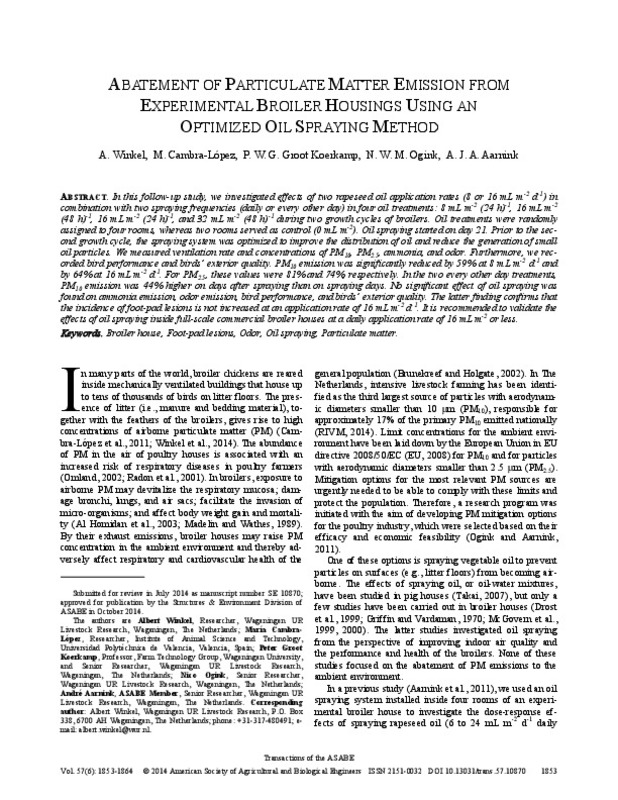JavaScript is disabled for your browser. Some features of this site may not work without it.
Buscar en RiuNet
Listar
Mi cuenta
Estadísticas
Ayuda RiuNet
Admin. UPV
Abatement of Particulate Matter Emission in Broiler Houses Using an Optimized Oil Spraying Method
Mostrar el registro sencillo del ítem
Ficheros en el ítem
| dc.contributor.author | Winkel, A.
|
es_ES |
| dc.contributor.author | Cambra López, María
|
es_ES |
| dc.contributor.author | Groot Koerkamp, PWG
|
es_ES |
| dc.contributor.author | Ogink, Nico
|
es_ES |
| dc.contributor.author | Aarnink, André Johannes Antonius
|
es_ES |
| dc.date.accessioned | 2016-05-19T07:00:16Z | |
| dc.date.available | 2016-05-19T07:00:16Z | |
| dc.date.issued | 2014 | |
| dc.identifier.issn | 0001-2351 | |
| dc.identifier.uri | http://hdl.handle.net/10251/64346 | |
| dc.description.abstract | [EN] In this follow-up study, we investigated effects of two rapeseed oil application rates (8 or 16 mL m-2 d-1) in combination with two spraying frequencies (daily or every other day) in four oil treatments: 8 mL m-2 (24 h)-1, 16 mL m-2 (48 h)-1, 16 mL m-2 (24 h)-1, and 32 mL m-2 (48 h)-1 during two growth cycles of broilers. Oil treatments were randomly assigned to four rooms, whereas two rooms served as control (0 mL m-2). Oil spraying started on day 21. Prior to the second growth cycle, the spraying system was optimized to improve the distribution of oil and reduce the generation of small oil particles. We measured ventilation rate and concentrations of PM10, PM2.5, ammonia, and odor. Furthermore, we recorded bird performance and birds’ exterior quality. PM10 emission was significantly reduced by 59% at 8 mL m-2 d-1 and by 64% at 16 mL m-2 d-1. For PM2.5, these values were 81% and 74%, respectively. In the two every other day treatments, PM10 emission was 44% higher on days after spraying than on spraying days. No significant effect of oil spraying was found on ammonia emission, odor emission, bird performance, and birds’ exterior quality. The latter finding confirms that the incidence of foot-pad lesions is not increased at an application rate of 16 mL m-2 d-1. It is recommended to validate the effects of oil spraying inside full-scale commercial broiler houses at a daily application rate of 16 mL m-2 or less. | es_ES |
| dc.language | Inglés | es_ES |
| dc.publisher | American Society of Agricultural and Biological Engineers | es_ES |
| dc.relation.ispartof | Transactions of the ASABE | es_ES |
| dc.rights | Reserva de todos los derechos | es_ES |
| dc.subject | Foot-pad lesions | es_ES |
| dc.subject | Broiler house | es_ES |
| dc.subject | Odor | es_ES |
| dc.subject | Oil spraying | es_ES |
| dc.subject | Particulate matter | es_ES |
| dc.subject.classification | BIOLOGIA ANIMAL | es_ES |
| dc.subject.classification | PRODUCCION ANIMAL | es_ES |
| dc.title | Abatement of Particulate Matter Emission in Broiler Houses Using an Optimized Oil Spraying Method | es_ES |
| dc.type | Artículo | es_ES |
| dc.identifier.doi | 10.13031/trans.57.10870 | |
| dc.rights.accessRights | Abierto | es_ES |
| dc.contributor.affiliation | Universitat Politècnica de València. Departamento de Ciencia Animal - Departament de Ciència Animal | es_ES |
| dc.description.bibliographicCitation | Winkel, A.; Cambra López, M.; Groot Koerkamp, P.; Ogink, N.; Aarnink, AJA. (2014). Abatement of Particulate Matter Emission in Broiler Houses Using an Optimized Oil Spraying Method. Transactions of the ASABE. 57(6):1853-1864. doi:10.13031/trans.57.10870 | es_ES |
| dc.description.accrualMethod | S | es_ES |
| dc.relation.publisherversion | https://dx.doi.org/10.13031/trans.57.10870 | es_ES |
| dc.description.upvformatpinicio | 1853 | es_ES |
| dc.description.upvformatpfin | 1864 | es_ES |
| dc.type.version | info:eu-repo/semantics/publishedVersion | es_ES |
| dc.description.volume | 57 | es_ES |
| dc.description.issue | 6 | es_ES |
| dc.relation.senia | 287571 | es_ES |
| dc.identifier.eissn | 2151-0040 |








